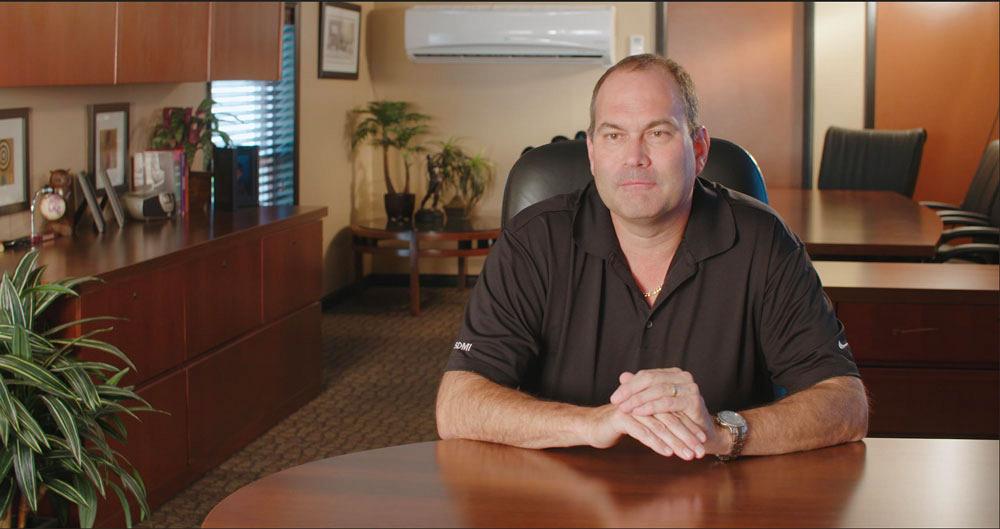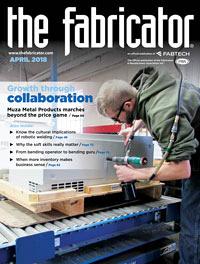President
- FMA
- The Fabricator
- FABTECH
- Canadian Metalworking
Categories
- Additive Manufacturing
- Aluminum Welding
- Arc Welding
- Assembly and Joining
- Automation and Robotics
- Bending and Forming
- Consumables
- Cutting and Weld Prep
- Electric Vehicles
- En Español
- Finishing
- Hydroforming
- Laser Cutting
- Laser Welding
- Machining
- Manufacturing Software
- Materials Handling
- Metals/Materials
- Oxyfuel Cutting
- Plasma Cutting
- Power Tools
- Punching and Other Holemaking
- Roll Forming
- Safety
- Sawing
- Shearing
- Shop Management
- Testing and Measuring
- Tube and Pipe Fabrication
- Tube and Pipe Production
- Waterjet Cutting
Industry Directory
Webcasts
Podcasts
FAB 40
Advertise
Subscribe
Account Login
Search
Team building central to custom fabricator’s success
If people don't work well together, nothing else matters
- By Joe Morgan
- April 6, 2018
- Article
- Shop Management
Consider a multiprocess workcell with a cutting machine next to bending and other operations. Identify product families that fit the cell, move those machines together, and voila, you see parts moving quickly from one process to the next.
It seems to be lean thinking at its finest. Lead times plummet, cash flow rises, and all is well with the world—right? As we’ve found at Square Deal Machining Inc. (SDMI), it’s not that straightforward. If people don’t work well together, they can’t be effective.
SDMI is a custom fabricator and machine shop that has grown significantly over the past 20 years. In that time, the company has transformed from a modest, one-room machine shop in rural upstate New York into a multisite company with more than 300,000 square feet of manufacturing space and more than 300 employees.
But our company wouldn’t have grown so dramatically if we had focused only on the “hard” aspects of operating a custom fabricator—the processes and the technology. We also focus on the people, and not in a superficial way. A company is, at its heart, a group of people working together.
A team does need the right tools and technology to succeed. But if that team is dysfunctional—due to mismatched personalities, working styles, or anything else—success becomes impossible.
A Good Team
Consider a hypothetical team assigned to a value stream or workcell. First we have Jack, a creative engineer who develops, directs, and controls product design. We also have Kevin, a hands-on worker who operates machinery that fabricates the product. Next we have Anna, a worker with a broad skill set who also excels at details; she’s responsible for testing and control to ensure the product’s quality. Finally, we have David, a quiet yet diligent worker who handles packaging and delivery.
In this case, Jack is the team leader; he has the leadership skills to direct the general workflow. Anna has exacting standards, so she excels in quality assurance. Both Kevin and David have the practical skills to produce, assemble, and deliver a quality batch of products.
At SDMI, we’d consider this a balanced team, with skills and work styles that complement each other. A team that is well-balanced will thrive, create more product in less time, and ultimately allow the company to be more profitable. Conversely, a team that’s poorly planned and structured will lead to dysfunction, which will eventually eat into profits.
We’ve found this to be especially true when implementing new technologies. This includes our new laser tube cutting machine, capable of processing round and square tube up to 10 inches in diameter, in addition to structural beams and other open profiles. The machine has simplified many cut-and-form jobs and given customers a plethora of customization options.
However, now that we’ve expanded our fabrication services, it has become more critical than ever to make sure that we have a team fully capable of delivering these services. That team must work as a cohesive unit that embraces the technology. We need a leader who continually questions the status quo. Is the design of this tube assembly truly impossible? Or can we make the seemingly impossible possible? We also need people who thrive on hands-on work and who know the new technology inside and out. Fortunately, we now have such a team in place. The result: Our expansion into tube cutting has really paid off.
Defining a Good Fit
Our human resource department administers the Myers-Briggs Type Indicator®, a popular personality assessment widely used across various businesses. Still, the assessment is only part of the process.
Our managers make it a point to truly know and understand the strengths, weaknesses, goals, and interests of each employee. It begins on an employee’s first day with in-depth interviews and continues with one-on-one training sessions between managers and employees. We feel that such ongoing training and evaluations are critical, and they shouldn’t end after a person is hired.
Our hiring process isn’t brief, but it is time well-spent. Whether we hire an engineer, a machine operator, or any other position, the process is largely the same. We diligently review resumes and references like most other employers would, but the most valuable part of the process is the face-to-face interaction with a prospective employee. If after initial interviews we feel confident an individual will be an asset to our team, we shift focus and determine where that individual best fits within the company.
Experience matters, but we are much more concerned about whether the potential hire will fit with our company culture. Many questions about the employee’s personality are simple and direct—likes and dislikes, for instance. But I feel the best way to make an accurate assessment, revealing who employees are and how well they will perform, is to ask questions about hypothetical scenarios. For example, “Here is the situation, and here is the problem. How would you handle it?” Their answers should give insight into how an employee might act, and react, on the job.
We value our team members and enjoy time spent getting to know them, but there’s a larger, overriding reason we put so much time and effort into these evaluations. The more we know, the better chance we have finding a place for that employee to thrive.
For instance, employees who enjoy interacting with others are fantastic candidates for positions like sales, planning and product development, or perhaps managing a small team in a workcell. Detail-oriented employees who appreciate a set routine thrive in quality assurance roles where they oversee each step of a complex manufacturing process and check products for defects.
Imagine a scenario involving two (again, hypothetical) employees, Sarah and John. Both have similar experience and job knowledge. Both are even detail-oriented and appreciate being part of an organized system made up of small, specific steps. Because of these similarities, they both work on the same team.
John is quiet and reserved, though he enjoys working as part of a team. Meanwhile, Sarah is extremely comfortable both issuing and receiving direction and naturally tends to offer guidance to others. So within this team, Sarah takes on the project management role while John focuses on the actual creation or inspection of the product. No one position is more important than the other; we need both to thrive and grow.
Knowing employees’ strengths allows managers to calculate how and where that worker can best serve the company. We then develop worker assignments and training methods accordingly.
Despite our best efforts to learn about employees throughout hiring and training, we still take a small leap of faith. We cannot be 100 percent certain employees will be successful in specific roles, or that they will be successful with the company at all.
Regardless, our hiring and training processes certainly better prepare us to make informed decisions, giving us a greater chance of hiring success. In those rare instances in which an employee does not perform as well as expected on a certain task, we identify and mitigate those issues quickly and, if necessary, reassign the employee accordingly.
The Client Perspective
Fabrication takes more than internal team building. It also requires healthy, productive interactions with customers. After all, without customers, we have no business.
Our clients are as unique as our employees. We try to understand not only their manufacturing and business needs, but also their personal preferences. And those personal preferences are key. A salesperson having expertise in a certain manufacturing sector is certainly important, but even more important are those personal preferences—how a salesperson interacts with a client representative. A salesperson may have experience in a certain field, but that salesperson also needs to communicate effectively with the client.
Clients have more options and higher expectations than ever before. They are more vocal and involved with the design process, and they want orders to be filled precisely and promptly. If one customer appreciates a great deal of individual attention and frequent communication, we strive to pair that customer with the right salesperson to serve as the primary point of contact.
Flourishing on the Job
When employees flourish, they execute production steps faster and more efficiently, and they produce better products. They excel and engage, and they become excited about the tasks they need to perform. This leads to higher employee retention, greater morale, and a more positive work environment.
All these results are largely supported by science. A 2015 study by researchers at the U.K.’s University of Warwick demonstrated that productiveness improved by 12 percent when employees experience long-term happiness at work.
Understanding where employees excel—and assigning their duties, customers, and colleagues accordingly—leads to greater employee retention and contentment. This contributes to the greater good of a manufacturing operation by increasing output, effectiveness, client satisfaction, and company morale.
Never underestimate the value of investing time and effort toward knowing and understanding your employees. When you invest in your employees, you invest in your company.
Joe Morgan is president of Square Deal Machining Inc., 98 US-11, Marathon, NY 13803, 607-849-3502, www.squaredealinc.com.
About the Author

Joe Morgan
98 US-11
Marathon, NY 13803,
607-849-3502
subscribe now

The Fabricator is North America's leading magazine for the metal forming and fabricating industry. The magazine delivers the news, technical articles, and case histories that enable fabricators to do their jobs more efficiently. The Fabricator has served the industry since 1970.
start your free subscription- Stay connected from anywhere

Easily access valuable industry resources now with full access to the digital edition of The Fabricator.

Easily access valuable industry resources now with full access to the digital edition of The Welder.

Easily access valuable industry resources now with full access to the digital edition of The Tube and Pipe Journal.
- Podcasting
- Podcast:
- The Fabricator Podcast
- Published:
- 04/16/2024
- Running Time:
- 63:29
In this episode of The Fabricator Podcast, Caleb Chamberlain, co-founder and CEO of OSH Cut, discusses his company’s...
- Industry Events
16th Annual Safety Conference
- April 30 - May 1, 2024
- Elgin,
Pipe and Tube Conference
- May 21 - 22, 2024
- Omaha, NE
World-Class Roll Forming Workshop
- June 5 - 6, 2024
- Louisville, KY
Advanced Laser Application Workshop
- June 25 - 27, 2024
- Novi, MI

































